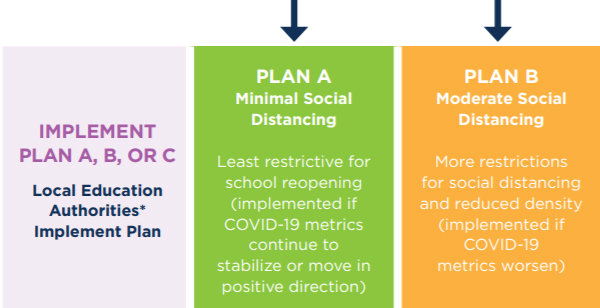

Written by Emily Hooks
When students return for the fall semester, they will not have been in a school building for six months. The regular challenges of a new school year, including scheduling, bus routes, classroom assignments, grading policies, and staff assignments will all be compounded by COVID-19. In this post, we explain next steps for developing plans to safely reopen schools.
On June 8, the North Carolina Department of Health and Human Services (NCDHHS) released StrongSchoolsNC: Public Health Toolkit (K-12), which contains requirements and recommendations for local education leaders and local education agencies (LEAs) to prepare and plan for school reopening. The Governor’s office, NCDHHS, the North Carolina State Board of Education (NCSBE), and the North Carolina Department of Public Instruction (NCDPI) will utilize the state or region’s COVID-19 metrics to determine how schools can safely reopen for the 2020-2021 school year. To prepare for reopening, LEAs are required to create three plans based on the level of restriction necessitated by the direction of the metrics. These plans must meet restrictions as outlined in the StrongSchools NC toolkit, described as Plan A: Minimal social distancing; Plan B: Moderate social distancing (requires increased restrictions); and Plan C: Remote learning only (school buildings would be closed).

In early July, Governor Cooper, in consultation with NCDHHS, NCSBE, and NCDPI, is expected to announce which plan should be implemented for the beginning of the 2020-2021 school year. LEAs can implement a more restrictive plan, but not a less restrictive one, and the plan can be changed if the state or a region’s COVID-19 metrics improve or worsen. If metrics allow for schools to reopen under Plan A or Plan B, schools will have to make significant changes to meet the requirements in:
Under Plan B, schools are required to take all the above precautions and limit the density in school transportation vehicles and school facilities to no greater than 50% maximum occupancy. They must also ensure there are at least six feet between people at all times in school facilities and transportation vehicles. NCDPI’s guidance contains different scheduling approaches for reduced capacity:
If school buildings are open under Plan A or Plan B, schools will conduct temperature screenings for all people entering school buildings or boarding school transportation. Students, staff, and visitors will also fill out a symptom screening checklist. NCDPI’s guidance encourages schools to coordinate these screenings with school nursing staff, but North Carolina averages one nurse to every 1,021 students. In 2017, only 46 of 115 LEAs met the federally recommended nurse-to-student ratio of 1:750. The Program Evaluation Division determined in 2017 that meeting the federal recommendation would cost up to $79 million annually. House Bill 1203 and Senate Bill 850 would require at least one school nurse in every school building; both bills have been filed and are in committee review.